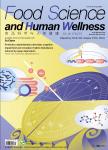Glyoxal induced advanced glycation end products formation in chicken meat emulsion instead of oxidation
Glyoxal induced advanced glycation end products formation in chicken meat emulsion instead of oxidation作者机构:College of Food Science and TechnologyNanjing Agricultural UniversityNanjing 210095China Center Testing International Pinbiao(Jiangsu)Certifi cation Technology Co.Ltd.Nanjing 210046China Shenzhen Key Laboratory of Marine Microbiome EngineeringInstitute for Advanced StudyShenzhen UniversityShenzhen 518060China Nanjing Huangjiaoshou Food Science and Technology Co.Ltd.Jiangsu Research Center for Livestock and Poultry Products Processing Engineering TechnologyNanjing 211200China
出 版 物:《Food Science and Human Wellness》 (食品科学与人类健康(英文))
年 卷 期:2022年第11卷第4期
页 面:828-836页
核心收录:
学科分类:0832[工学-食品科学与工程(可授工学、农学学位)] 1004[医学-公共卫生与预防医学(可授医学、理学学位)] 08[工学] 083203[工学-农产品加工及贮藏工程]
基 金:supported by Postgraduate Research&Practice Innovation Program of Jiangsu Province(KYCX21_0579) the China Scholarship Council(No.202006850022) supported by Agriculture Research System of China(CARS-41-Z) Science and Technology Project of Nanjing City(No.202002040)。
主 题:Glyoxal Emulsion Oxidation Advanced glycation end products Chicken meat
摘 要:Advanced glycation end products(AGE) are potential harmful substances formed in the advanced Maillard reaction and increasingly investigated in muscle foods. However, the contribution of oxidation to the AGE formation is controversial. Moreover, reports on glyoxal(GO) induced AGE formation in chicken meat emulsion(CME) are limited. Thus, the effects of GO on emulsifying properties, rheological behavior and AGE formation in CME were investigated. Our findings exhibited that levels of Nε-carboxymethyllysine(CML) and Nε-carboxyethyllysine(CEL) were associated with lipid oxidation but not significantly(P 0.05). Levels of AGE peaked when GO concentration ranged from 5 mmol/L(CML) to 10 mmol/L(CEL). The droplets’ aggregation associated with the disulfide bond when the concentration of GO was at 0.5–30 mmol/L while non-disulfide bond association occurred at 30–50 mmol/L GO concentration. In conclusion, compared to the effect of oxidation, GO exhibited the main role in the AGE formation of CME. This study will provide theoretical significance for further understanding and controlling the formation of AGE in CME.



